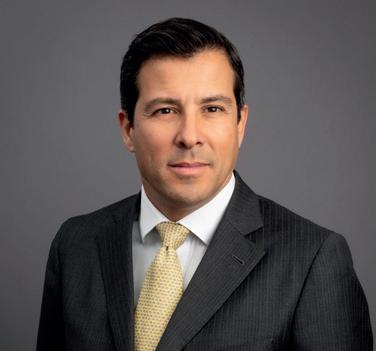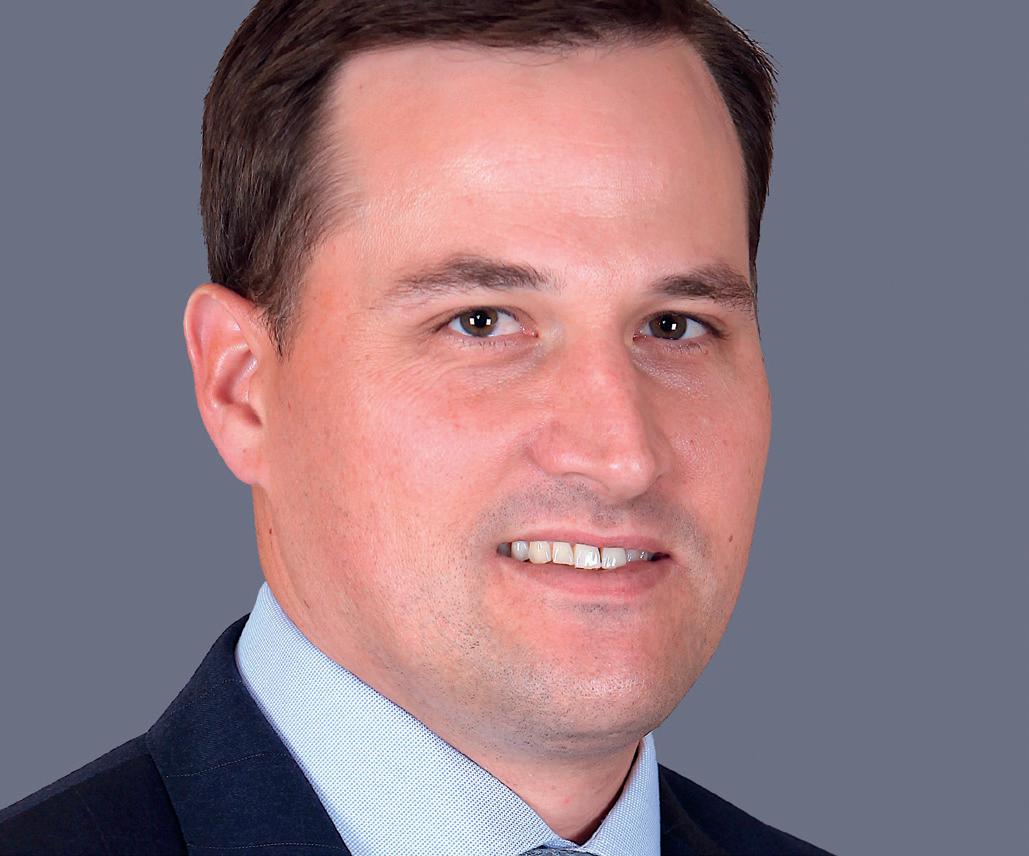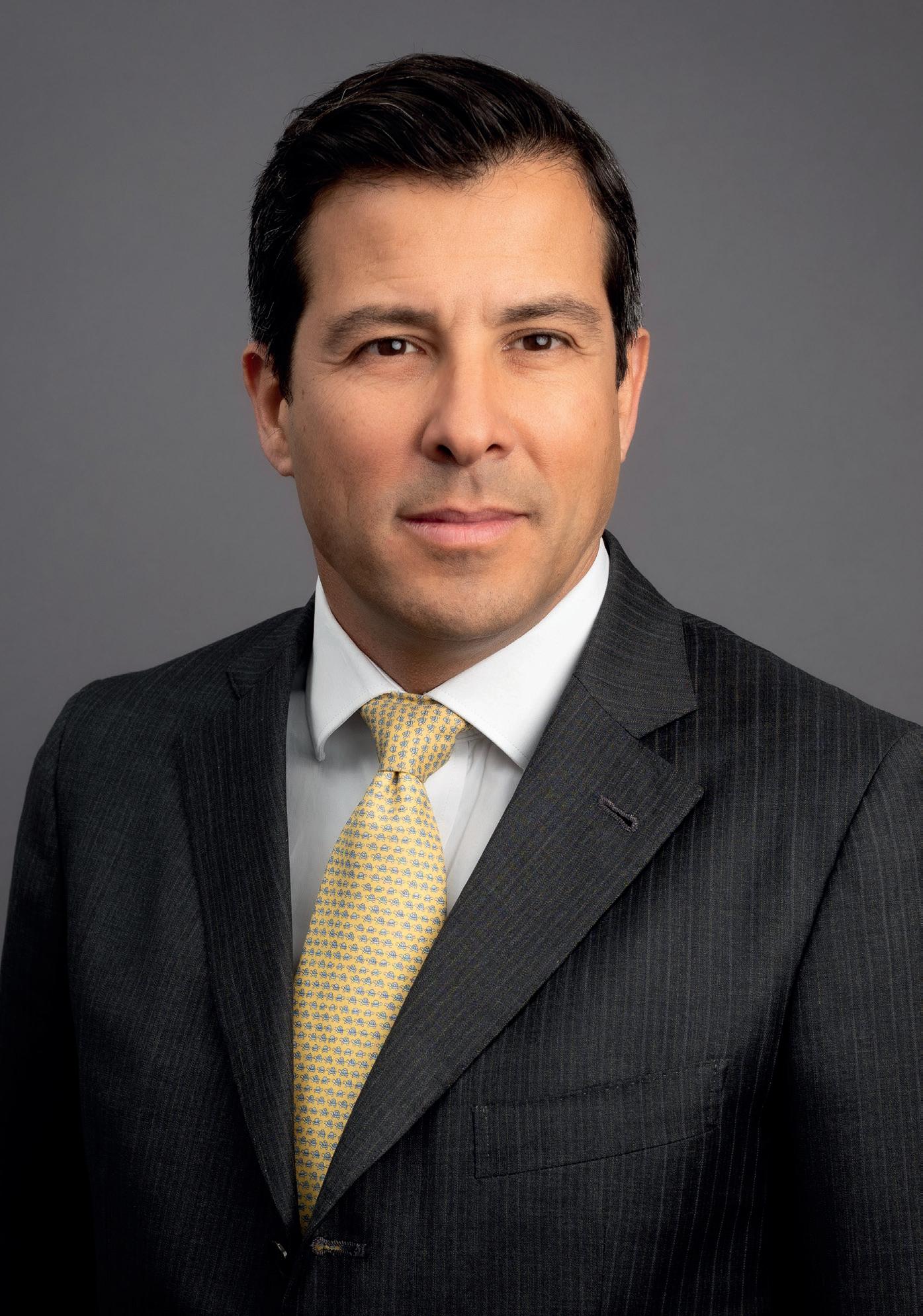

Clearlake Credit eyes wealth market and more acquisitions for growth
CLEARLAKE Credit, the unified credit business recently launched by Clearlake Capital, is remaining “acquisitive” as part of its ambitious growth plans.
Clearlake Capital was launched in 2006 and now manages $90bn (£66.8bn) of assets across private equity and private credit strategies. It launched the new credit division in May after making two acquisitions in the credit space.
Clearlake Credit incorporates MV

Credit, a pan-European private credit manager that Clearlake Capital
recently acquired from Natixis Investment Managers, and WhiteStar
Asset Management, a credit-focused investment manager it bought in 2020, as well as Clearlake Capital’s existing credit business.
James Pade (pictured), a partner and managing director who has been with the firm since 2013, has been tasked with overseeing the new credit division.
“We’re big believers that we need to fully integrate our credit business, so with the acquisition of MV Credit, we thought now is the time to




















The numbers don’t lie.
The top 10 global investment banks, CLO managers, asset managers and AmLaw firms all rely on Octus for our trusted deal analysis, credit intelligence and data. Do you?
Get to know Octus by the numbers. Scan the QR code. Powerful truths. Better credit decisions.




North America has traditionally dominated the alternative credit sphere, but it looks like Europe is having its moment in the sun.
US policy uncertainty has driven North American investors to look across the pond for opportunities, attracted by higher returns and a less competitive market. Europe’s private credit fund managers are reaping the benefits.
Last month, London-based NorthWall Capital reported a “significant increase” in institutional inflows this year, which it attributed to growing interest in Europe’s credit market.
And Permira’s Ian Jackson told Alternative Credit Investor that limited partners were contemplating whether they were overexposed to the US, which has benefitted the firm.
Of course, with wars raging in Ukraine and the Middle East, the future for Europe and the rest of the world is far from certain.
But it will be interesting to see if increasing demand for European private credit leads to a prolonged period of growth, even after the global trade wars abate.
SUZIE NEUWIRTH EDITOR-IN-CHIEF
cont. from page 1
launch Clearlake Credit,” Pade told Alternative Credit Investor
“We want to provide an all-encompassing onestop-shop for sponsors. If a sponsor is doing a deal but hasn’t yet decided on the financing, we want to show them Clearlake Capital can solve an array of financing needs.”
Historically, it has been difficult for private equity sponsors to satisfy all their lending needs with one firm. But increasingly, asset managers are looking to offer a range of credit products, so that they can lend across the capital stack and sponsors do not have to work with several different lenders on just one deal.
For Pade, that is why it was important to have one integrated origination team that can speak across the different products the company has to offer.
With WhiteStar Asset Management, the firm has liquid credit capabilities across the US and Europe, including collateralised loan obligations, and with MV Credit it has bolstered its private credit offering, which provides senior, junior and other hybrid debt and capital solutions to sponsor-backed companies. It targets investments of up to

$1bn and has deployed more than $57bn into liquid and illiquid credit investments so far.
According to sources close to the business, Clearlake is also keeping its eye on the growth in asset-based lending and fund financing and could enter these markets as well, although Alternative Credit Investor understands there are no imminent plans.
Pade says that the team is “very focused on growing the business…through a
combination of organic and inorganic activity” and that it will “continue to be acquisitive”.
“We believe in scaling the platform by putting more product through the existing team we have,” he added.
The wealth market will also play a part in these growth plans, as Pade believes that private credit is particularly well suited to individual investors.
“We think credit is a great product for the wealth community,”
he said. “Having a mix of liquid and private credit, which provides liquidity as needed as well as yield, is an appropriate product for retirement planning.
“We understand that investors would like to have broader access to credit products and a mix of both liquid and private credit. Clearlake has at least one hybrid product today where we have a mix of private credit and more liquid credit within the portfolio.”
UK retail investors missing out on alts
UK RETAIL investors may be missing out on the benefits of alternatives because of regulatory restrictions.
The UK’s financial watchdog, the Financial Conduct Authority (FCA), aims to prevent retail investors from investing in complex or high-risk investments that they may not understand, including alternatives.
Retail investors who do wade into alternatives must give up certain protections, such as the transparency provided by public markets and access to the Financial Ombudsman Service.
However, this may be discouraging more experienced investors unnecessarily, while leading to poorer outcomes for those who invest in the space, according to Alex Davies, chief executive of Wealth Club.
“In most cases, the credit risks in private credit are comparable to those seen in the publicly traded investment grade, high yield and ABS markets – all asset classes that are firmly within the scope of what’s available to retail investors,” he said.
“But the result of the current regulation is that many retail investors can’t access alternatives at all, except through

the few publicly traded investment trusts.
“For those that do, the higher level designation means giving up certain protections, with the result that the alternative investment space is at risk of being targeted by rogue or poor operators operating in a regulatory grey zone.
“That is bad news for the investors and bad for the perception of the alternatives investment universe more generally.”
He added that this also means it is difficult to access alternatives through conventional retail investment wrappers, such as ISAs and Sipps, which can penalise high-networth retail investors.
“That is a serious problem for higher earning investors, especially in private credit,
who face punishingly high rates of tax on returns,” he said.
Davies also said that UK structures are currently at a disadvantage compared to those in other countries. For example, European semiliquid funds are designed to be better suited to smaller investors than traditional closed-ended, GP/LP fund structures.
“In the UK, these structures can only be sold to professional investors, but their US sibling, the perpetual Business Development Company, is far more widely available, and, as a result, has successfully raised hundreds of billions of dollars,” he said.
However, some experts think it is right that retail investors should continue to be discouraged from investing in alternatives.
“The industry has been vocal about opening up private markets to retail investors, and, given that this would unlock billions of dollars of capital, it’s easy to see why,” said Myles Milston, chief executive of private markets tech firm Globacap.
“However, this may not be in the best interests of retail investors, as private markets operate a lot differently than the public markets they’re used to investing in. Private assets are less liquid, fees are higher, and it’s very difficult to get transparency into the value of assets.
"Pure retail investors should be wary of investing in opportunities where their investment can be locked up for a long, undefined time period.”
Investors may not understand ABF
INVESTORS need
to ensure they fully understand the nuances of asset-backed finance (ABF), experts have warned, amid rapid growth of the asset class.
ABF is increasing in popularity, as private credit investors look to diversify their portfolio and earn higher returns, with the benefit of security. But it is important for investors to understand the assets behind the ABF debt itself.
“The idea behind ABF is that lenders will gain exposure to collateral that can be liquidated in
an enforcement scenario,” said Luke Chan, partner and head of private credit at HighVista Strategies. “However, if collateral is low quality, lenders may sustain losses.”
Chan has also warned new investors to avoid making false comparisons with other areas of private debt.
“Unlike EBITDAbased lending, which can be executed upon by a generalist team, ABF requires specialised teams able to underwrite and work with each underlying collateral type,” he added.
Albane Poulin, head of
private credit at Gravis Capital Management, explains that stakeholders need “deep expertise” in assessing the quality of assets.
“It’s not just about understanding the asset’s intrinsic value, but also about knowing the legal framework around enforcement in the event of default, such as whether to appoint a receiver or initiate administration proceedings, and how quickly the asset can be liquidated under current market conditions,” she said. “As a result, assetbacked lending calls for
a blend of skills: asset valuation, legal and structuring expertise (especially around security agreements), and strong credit underwriting capabilities.
“When lending against infrastructure assets, an additional layer of insight is needed –specifically, a thorough understanding of regulatory frameworks and the underlying technology – to properly assess the long-term value and resilience of the collateral.”
For more on assetbased finance, read the feature on page 14.
Shortlist announced for Alternative Credit Awards
THE SHORTLIST has been announced for the Alternative Credit Awards 2025.
The awards, hosted by Alternative Credit Investor, recognise the most influential fund managers, specialist lenders and service providers shaping the alternative credit space. Go to alternativecreditinvestor. com and our dedicated awards website, alternativecreditawards. com, to access the shortlist and read the latest updates about the Alternative Credit Awards.

The shortlist and winners are decided by Alternative Credit Investor’s editorial team and a panel of independent judges.
“I’m delighted that the shortlist has now been unveiled for this
year’s Alternative Credit Awards,” said Suzie Neuwirth, founder and editor-in-chief of Alternative Credit Investor.
“The quality and breadth of entries this year was overwhelmingly high,
so it was a difficult task for our judging panel to whittle down the shortlist.
“I can’t wait to reveal the winners at November’s awards ceremony!”
The Alternative Credit Awards take place on Wednesday 19 November 2025 at the Royal Lancaster London, a five-star hotel located by Hyde Park.
For table and sponsorship enquiries, please contact sales and marketing manager Tehmeena Khan at tehmeena@ alternativecreditinvestor. com
‘Retailisation’ of evergreen funds raises concerns
EVERGREEN funds are increasingly targeting the retail market, but experts are concerned that these strategies are more risky when retail investors are involved.
Concerns have also been raised that the shift towards retail has led to evergreen strategies attracting lower-quality assets.
Evergreen funds have soared in popularity in private credit over the past few years, with assets under management held in these strategies hitting $500bn (£368bn) in 2024, according to With Intelligence.
Earlier this month, Partners Group’s private credit evergreen fund hit €2bn (£1.7bn), and in May, CVC Capital Partners said it had raised over €1bn in its two evergreen funds less than one year after launch.
“Most large private debt managers are considering an evergreen product, with several in the process of launching one,” said Sam Brooks, partner at law firm Macfarlanes.
These funds have already seen a surge in popularity among institutional investors.
But a recent survey by the Alternative Investment Management Association found four in 10 managers developing evergreen

funds were aiming to target retail investors.
So, what is driving the popularity of evergreen structures in the retail market? Demand for increased liquidity is the main factor, according to Bryan Astheimer, head of SEI’s Investment Managers business for EMEA.
“Having more liquidity options is perhaps the biggest reason investors would be attracted to an evergreen fund,” he said.
"The flexibility to add and withdraw capital outside of a 10-to-12year lockup is going to propel investors to an evergreen model."
Despite the surge in popularity, some experts have raised concerns that evergreen funds are more complex to run, particularly when retail investors are involved, and this increases their risk.
“Offering a more liquid, perpetual version of a fund adds multiple layers of complexity across the entire firm, both in the back office and with the investor relations team – even more so if the fund will be offered to the non-institutional market, ” Astheimer said.
“The simple fact is that with more transactions, more NAVs to strike, and more reporting that needs to be accomplished, the risk for error elevates.”
Some experts have also suggested that evergreen funds targeting retail investors tend to attract lower-quality assets, as retail investors typically do less due diligence.
However, Jay Bala, chief executive of AIP Asset Management, said while this is “a concern rooted in a valid question, the assumption isn’t necessarily accurate”.
“The notion that evergreen funds house weaker credits because retail investors do less due diligence misunderstands how professional asset management works,” he said.
“Whether the capital is institutional or retail, every investment goes through a rigorous process – focusing on downside protection, capital structure and potential for upside above and beyond interest income."
He added that the biggest issue for evergreen funds going forward will not be around who the investor is, but how the fund is governed.
“The most successful evergreen funds are the ones built with thoughtful liquidity planning, quality asset sourcing, and a deep understanding of investor needs,” he said.
Why Arrow’s local platform model is built for the European mid-market
By Enrico Sanna (pictured right), CEO Platforms, Arrow Global
WHEN I SPEAK WITH institutional investors looking to deploy capital into European mid-market real estate and private credit, I am often asked a very fair question: why has Arrow built such a broad, vertically integrated business? Why do we need 24 operating companies and over 4,400 people across eight countries? Does this not make us operationally heavy in a world that prizes lean, asset-light models?
My answer is simple. We did not build this business because it was easy, we built it because it was necessary. Europe is not one market; it is 44. Each country has its own regulatory regime, banking system, tax and insolvency laws, language, and culture.
For investors used to the scale and uniformity of the US, the European landscape can seem highly fragmented. But for Arrow, that fragmentation is precisely where the opportunity lies. Europe’s private credit markets are fundamentally local: 82 per cent of Eurozone lending remains domestic, and around €14tn (£11.9tn) in middlemarket, asset-backed exposures are deeply embedded within national systems. These are profoundly local opportunities that cannot be efficiently securitised or outsourced. By controlling the ‘last mile’ of lending, whether it’s bridging loans in the UK or residential development in Spain, Arrow converts this structural complexity
into sustained alpha. Our business exists to turn complexity into competitive advantage, to transform local presence into proprietary access, and to control risk and retain maximum value by remaining directly engaged at every stage of the investment lifecycle, not by outsourcing or distancing ourselves through layers of intermediaries.
From the beginning, Arrow was designed to operate within this fragmented complexity. We saw the most attractive investments, those with the greatest asymmetry between risk and return, were often small, non-core, or distressed assets sitting below the radar of large institutions. These deals do not appear in broker-led auctions or pan-European portfolios. They are found in local insolvency proceedings, in long-standing relationships with banks and servicers, in regional developer platforms, and in legacy situations that require patience, credibility, and cultural understanding to unlock. And they are rarely more than €20m to €50m in size, far too small for global capital pools, but exactly the kind of granular investment that, if managed correctly, can drive strong returns that are largely uncorrelated with broader market cycles. Thanks to this embedded network, we are consistently able to source and execute transactions in the €20m to €30m range, typically too small for institutional
capital and in the majority of cases entirely off-market.
To find and execute these deals, you need to be local. That is why we built our business the way we did. Each of our local platforms, from Maslow in the UK and Zenith in Italy, to Norfin in Portugal, Galata and Amitra in Spain, iQera in France, Mars in Ireland, and Interboden in Germany, plays a strategic role. These are not bolt-on subsidiaries. They are integrated engines of origination, underwriting, servicing, and asset management. They bring us realtime intelligence, privileged deal flow, and deep market knowledge that no centralised team sitting in London or New York could replicate. And importantly, they have been brought into the Arrow family through longterm partnerships and joint ventures, not opportunistic rollups. This ensures cultural alignment, continuity, and trust.
The value of this structure becomes clearest in times of dislocation. In Germany, for example, we recently acquired Interboden, a respected longestablished, family-owned development business that had entered insolvency. But we did not just acquire the assets. We took on the entire operating platform: the employees, the relationships, the know-how. That acquisition added over €500m in GDV to our pipeline and firmly established our presence

in a market where the current opportunity set is defined not by large-scale distress, but by granular, misaligned capital structures that need hands-on resolution. Without a local platform like Interboden, we would not have had the visibility or execution capability to act with such speed and confidence.
What makes Arrow’s model even more powerful is that we do not just source or acquire assets, we closely
manage them through their full lifecycle. That requires operational control, which we maintain through our network of specialised platforms. We own master and special servicers like Arrow Global Massey in the UK, Zenith in Italy, and Galata in Spain. We have a credit bureau in the Netherlands, Focum, and a securitisation vehicle in Portugal, Hefesto. We manage legal processes through Drydens
Solicitors in the UK, and we operate extensive real estate and hospitality assets through platforms like Sansedoni in Italy and Details in Portugal. These are not just support functions. They are essential parts of our ability to price risk accurately, manage complexity, and execute business plans with precision.
When we underwrite a transaction, we do not just look at market comparables and broker forecasts. We use real performance data drawn from our servicing operations, covering more than 35 million loans and assets across our portfolio. We validate our assumptions through conversations with in-market professionals who understand pricing trends, legal developments, borrower behaviour, and policy shifts. And when we execute, we can mobilise local teams to reposition assets, implement ESG upgrades, restructure leases, and actively manage capital expenditure. This is how we transform underperforming or stranded assets into highperforming, exit-ready investments.
Of course, running a platform of this size and complexity takes careful coordination. That is where the interaction between our local and central teams becomes essential. Our local businesses operate with significant autonomy, but they are fully aligned to Arrow’s central investment and risk framework. The local teams bring us market perspective, origination leads, and operational insight. The central team in London handles portfolio construction, fund strategy, capital deployment, and risk management. We collaborate closely to vet opportunities, calibrate underwriting, and shape asset strategies. It is a loop, not a hierarchy. And that dynamic is
The world’s leading resource on alternative credit
Keep abreast of the latest news and updates on the fast-growing alternative credit market by connecting with Alternative Credit Investor magazine on social media.
Twitter/X: https://twitter.com/altcreditnews
Facebook: https://www.facebook.com/alternativecreditinvestor
LinkedIn: https://www.linkedin.com/company/ alternativecreditinvestor
Instagram: https://www.instagram.com/ alternativecreditinvestor
Access our website at alternativecreditinvestor.com


what allows us to be both agile and disciplined at the same time. Because our platforms operate across eight Western European countries, we can dynamically adjust our focus to best suit prevailing conditions, currently pursuing structured, downsideprotected positions in more conservative Northern jurisdictions while leaning into growth and recovery themes in the South.
This structure also gives us the flexibility to adapt our capital strategy. We hold our platforms on balance sheet, which means we can retain them when they are strategically aligned or divest selectively when they no longer fit our focus. In 2023, for example, we exited Capquest and Mars UK, businesses that were no longer core to our preference for assetbacked, mid-market assets. That level of strategic optionality is an advantage few asset managers have.
For institutional investors evaluating the European market today, the next cycle of outperformance is unlikely to come from scale alone. It will be driven by granularity, local insight, and disciplined execution. This
is not a market for passive capital or remote decision-making. It is a market for operators, those prepared to engage with complexity on the ground and create value asset by asset, market by market.
Arrow has built the infrastructure to deliver this. Our platform is weather-tested, our teams are in place, and our pipeline is strong. For institutional capital seeking access to Europe’s granular and underpenetrated asset-backed mid-market – across origination, asset management, and execution – we are already delivering results. In 2024, we invested €2.1bn and achieved €1.2bn in realisations, demonstrating both the depth of our opportunity set and the discipline of our exit execution. With €11bn in FUM and €112bn total AUM, both growing, our platform is positioned at scale and supported by a robust pipeline heading into 2025.
Importantly, this approach aligns powerfully with the structural tailwinds currently driving demand for private credit. Traditional banks have stepped back significantly from mid-market lending across Europe, constrained by balance
sheet pressures, heightened capital provisioning requirements, and the operational complexity of managing granular, cross-border exposures. Into that gap, private credit has moved with increasing momentum. The asset class continues to offer strong, riskadjusted returns, while providing downside protection through senior positioning in the capital structure. Investors are increasingly drawn to the predictability of outcomes, the regularity of interest payments, and the ability to match portfolios to longterm objectives. Add to that the diversity of strategies across the risk spectrum and the agility enabled by shorter fund durations, and private credit is emerging not just as a complement to private equity, but as a cornerstone allocation.
The unique makeup of our business, combining origination engines, servicing infrastructure, and asset-level execution across multiple jurisdictions, is purpose-built to capture these dynamics. At Arrow, we are not just active in the private credit opportunity, we are structurally positioned to lead within it.
Alternative Credit

The Alternative Credit Awards will take place on 19 November 2025, at the Royal Lancaster London.
The event – hosted by Alternative Credit Investor – is the only dedicated alternative credit awards ceremony in the UK and has quickly become a must-attend industry event.
The evening will comprise a champagne reception, gala dinner and awards ceremony, commemorating the shining stars of the alternative credit industry.
Fund managers, specialist lenders and service providers will be presented with accolades on the night.
Credit Awards 2025
Categories include Fund Manager of the Year, Senior Lender of the Year and Fund Administrator of the Year.
Go to our website at alternativecreditawards.com for more information about the awards.
Tables are limited so get in touch as soon as possible to secure your place.
For sponsorship and table enquiries, please email sales and marketing manager Tehmeena Khan at tehmeena@alternativecreditinvestor.com.

Hidden assets
The asset-backed finance market is growing at a rapid rate, but has investor understanding caught up at the same pace? Jon Yarker reports
ASSET-BACKED FINANCE
(ABF) is a rapidly growing area of private credit, with an increasing number of firms now creating dedicated strategies. This has seen competition intensify between private credit firms, eager to outmanoeuvre the others and seize market share, which is putting ABF at an interesting point in its development. One of the drivers behind ABF’s growth is its appeal for numerous investor bases.
“In our experience the increasing interest in ABF stems from investors who are either fully allocated to traditional cashflow lending and are looking to diversify their credit exposure, or do not want to allocate to traditional cashflow lending as they have enough exposure to those borrowers elsewhere in their portfolio,” explains Luke Chan, partner and head of private credit at HighVista Strategies.
This has seen ABF come in from the margins to be a core holding in some portfolios, as its qualities become recognised beyond diversification and increasingly towards the yield it can offer.
“ABF is increasingly becoming a core component of private credit portfolios, as it offers more stable and predictable cashflows,” says Albane Poulin, head of private credit at Gravis Capital. “Investors expanding their presence in the private markets are drawn to this asset class for its potential to
enhance portfolio diversification while generating consistent yield.
“However, investing effectively in this space requires access to specialised resources, expertise in structuring and valuation, and deep sector knowledge.”
CJ Wei, managing director of private credit at Northleaf Capital Partners, is also seeing ABF becoming a core holding and highlights the potential it can offer beyond simple yield enhancement.
“Asset-based lending can provide strong downside-protection to investments when you combine highly diversified portfolios with conservative structures, significant asset coverage, borrower alignment and lender-protective covenant protection,” says Wei. He also points to the asset class’s performance and valuations as typically being “very stable” as unlike public fixed income, these investments are not traded and therefore less vulnerable to market volatility.
ABF’s relative ‘newness’ is also helping it to increasingly command larger parts of investors’ portfolios. Wei says that ABF’s “emerging nature” can benefit early adopters.
“Given its emerging nature, there is still an imbalance of private lender demand versus

specialty finance borrower origination supply,” he says. “This dynamic provides attractive yields and the ability for ABF to generate strong risk-adjusted returns and structures.”
Getting to grips with ABF
Like with any asset class that finds itself coming into favour, a rush of allocations gives way to scepticism and questions about
“ ABF is increasingly becoming a core component of private credit portfolios”

hype. For instance, to what extent are investors committing to ABF simply because their peers are? This is true, to some extent, in some areas which could be suffering from hype according to Stephen Plagemann, chief financial officer at Mount Street. He points to new and innovative types of infrastructure projects, for example carbon capture and battery storage, as falling into this category.
“We are also seeing some interest from retail investors, due to the increased visibility of the asset class,” adds Plagemann. “However the long-term and illiquid nature of
the asset class creates difficulties in terms of getting the structure right.”
This has created a need to approach ABF with some distinction, especially given the wide range of assets ABF can give investors exposure to.
Here, Gravis’s Poulin argues for the need to distinguish between these different assets. Describing property, vehicles, equipment and energy infrastructure as “traditional” assets for ABF, as well as financial assets like consumer loans, she points out how these are different to “unconventional assets.” With the latter likely to include
assets like art, music royalties or litigation claims, Poulin highlights their tendency to have lower liquidity and less transparency.
“At Gravis, our focus is on "hard" assets, particularly infrastructure and real estate,” she explains. “We believe these sectors are more widely recognised, better understood and offer greater investment clarity.
“The core advantage of assetbacked lending lies in the presence of strong collateral, which enhances visibility on recovery value if a deal does not perform as expected. The use of wellunderstood and widely accepted assets as collateral improves loan liquidity and facilitates asset liquidation when necessary.”
Approaching ABF correctly The importance of the assets behind the ABF debt itself cannot be overstated, and this is an area which investors are having to spend more time trying to understand. As such, HighVista’s Chan argues that investors should be fully aware of the actual assets they are lending against.
“The idea behind ABF is that lenders will gain exposure to collateral that can be liquidated in an enforcement scenario,” he adds. “However, if collateral is low quality, lenders may sustain losses.”
Therefore, Chan says that investors tackling ABF need to be ready to trade around a wider range of assets given the flexibility ABF affords. In particular, he warns against newcomers taking false comparisons with other similar areas of private debt: “Unlike EBITDA-based lending, which can be executed upon by a generalist team, ABF requires specialised teams able to
underwrite and work with each underlying collateral type.”
Asset class specific considerations for ABF extend beyond the collateral supporting the debt. ABF investments are highly structured and can be more difficult to source than other asset classes in private credit. According to Northleaf’s Wei, there are several other aspects of ABF loans investors should be mindful of.
“ABF debt investments include a number of key structural benefits from significant asset coverage and wide ranging financial and asset covenants,” he says. “Embedded in the structures for ABF investments include a handful of financial and a range of eligibility criteria and concentration limits that govern a facility’s borrowing base, while ensuring a high level
“
If collateral is low quality, lenders may sustain losses”
of collateral diversification.
“It’s worth noting that ABF lenders are generally successful in securing call protections and granular reporting packages that allow for real time monitoring and a high degree of information access.”
This means not just any firm can get involved in ABF, if they want to do it correctly. Some may assume there are strong enough similarities with cashflow lending, but the wide variety of assets being used in ABF can only complicate the due diligence required. Here, Gravis’s Poulin argues that “deep expertise” in assessing the quality and enforceability of

these assets is needed, and the ability to delve deeper if needed.
“It’s not just about understanding the asset’s intrinsic value, but also about knowing the legal framework around enforcement in the event of default, such as whether to appoint a receiver or initiate administration proceedings, and how quickly the asset can be liquidated under current market conditions,” says Poulin. “As a result, asset-backed lending calls for a blend of skills:
asset valuation, legal and structuring expertise (especially around security agreements), and strong credit underwriting capabilities.
“When lending against infrastructure assets, an additional layer of insight is needed – specifically, a thorough understanding of regulatory frameworks and the underlying technology – to properly assess the long-term value and resilience of the collateral.”

Where next for ABF (and its liquidity)
Given the drivers supporting ABF’s growth in popularity have not changed, and it is still providing yield, diversification and structural protections to investors, the asset class is expected to make up a growing share of portfolios. HighVista’s Chan calls its continued expansion a “logical step” while Mount Street’s Plagemann expects investors to get more “comfortable”
with ABF as its benefits become more widely known.
Despite this optimism in the industry, ABF does raise some asset class-specific considerations that a growing cohort of newcomers will need to familiarise themselves with. Liquidity – or more specifically, a lack of it – is typically an issue that is not at the forefront of investors’ minds until something goes wrong. ABF is still an emerging asset class for many investors which
means liquidity has not become a primary concern yet, but this may be worth preparing for given the underlying assets supporting such debt could be hard to trade quickly.
“Investors should also be aware that secondary liquidity might not be available to the same degree as in other asset classes,” warns Plagemann. “However, the security packages available
“ Asset-backed lending calls for a blend of skills”
and over-collateralisation (if provided) allow investors to fully benefit from an illiquidity premium over other asset classes with comparable risk profiles.”
ABF’s increasing popularity looks set to continue, with this asset class attracting larger allocations and becoming a core holding for some. The merits of ABF are becoming more widely known, but the same cannot be said for the complexities of this area of private debt. Its structural nuances, as well as the fact it can open up investors to an extremely wide pool of underlying assets, means ABF is still currently better suited to those with the specialist expertise and resources to match. For instance, some ABF debt holders may find themselves in difficult situations if they needed to offload such positions, only to find the underlying assets are illiquid and hard to sell quickly.
If ABF’s adoption continues at its current pace, firms without the required knowledge and expertise in this area may be in for a steep learning curve.
The evolving golden age of private credit
By Octus Private Credit & Deal Origination Team
PRIVATE
CREDIT IS NOT
just a growing asset class; it is reshaping the financial ecosystem. What began as a niche solution for mid-market companies post-2008 has evolved into a $1.7tn (£1.3tn) industry, poised to reach $3.5tn in the coming years. But what is fueling this evolution? And why do experts continue to call this moment "the golden age" of private credit?
Addressing the golden age debate
Critics have questioned whether private credit has reached its saturation point, especially as syndicated loans staged a temporary comeback amid cheaper financing alternatives. Concerns about rising default rates or a looming "maturity wall" in 2026–2027 have also fueled speculation of slowdowns. However, data tells a different story. Default rates remain low, underwriting discipline remains strong, and private credit retains its
resilient advantage. The asset class has grown rapidly and continues to thrive, even with syndicated loans returning to the market.
Five
forces driving private credit
What makes private credit a continually rising force? Below are five key growth drivers making the industry thrive even amid economic shifts.
1. Macroeconomic volatility sparks opportunity
Private credit thrives during uncertainty. Rising interest rates, geopolitical tensions, and financial instability create circumstances where private lenders step in. By offering bespoke solutions, private credit funds capture deals traditional banks avoid.
2. Maturity walls are negotiable
The predicted maturity wall for

2026–2027 isn’t as ominous as headlines may suggest. Private lenders excel in renegotiating terms, tailoring solutions to stabilize borrowers before defaults occur.
3. More leverage buyouts and co-investments
Private equity sponsors increasingly prefer private credit for its speed and scalability. Co-investments further enable direct lenders to tackle largescale acquisitions, rivaling traditional syndicated loans.
4. Global expansion fuels opportunity
While North America accounts for the lion’s share of the private

credit market, Europe and AsiaPacific are quickly catching up. Geographic diversification creates new avenues in underbanked regions.
5. Consistently resilient yield potential
Thanks to floating-rate loans and disciplined underwriting, private credit achieves strong yields, even in volatile economies. This reliability keeps investors coming back.
Challenges in the shadows
Despite its growth, private credit remains a notoriously opaque asset class, with little public disclosure on terms like covenants or interest rates. This lack of transparency creates
challenges for both borrowers and lenders. Early intelligence on deals can provide a competitive edge, allowing firms to position debt packages, negotiate legal terms, and engage in conversations before competitors even notice.
The future of private credit
The road ahead for private credit is marked by sophistication. Far from declining, the asset class continues to evolve, driven by innovation and adaptability. Whether through cutting-edge data strategies or geographic expansion, private credit offers an edge for those ready to seize it.
For investors, borrowers, and financial institutions, staying informed is no longer optional. Businesses that leverage forwardthinking intelligence, like that provided by Octus, are primed to make smarter, timelier decisions.
Stay ahead
The golden age of private credit isn’t ending; it’s shifting into a new phase of opportunity. To stay competitive, you need real-time insights, actionable data, and a clear strategy to capitalize on this dynamic market.
At Octus, we transform opaque markets into clear, decisive intelligence. Access critical market data, expert analysis, and earlystage deal intelligence, all in one place.
Private credit is evolving. Are you evolving with it?
Learn more with Octus today, at octus.com.

